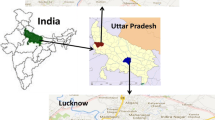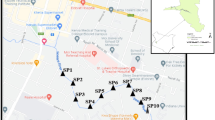Abstract
The availability of pharmaceutically active compounds (PhACs) in surface waters and suspended solids/sediments presents an ecological hazard of chronic exposure to non-target organisms. Thus, water and sediment samples were collected from the Korle Lagoon in the west of Accra-Ghana city center to evaluate 35 medicinal drugs belonging to the main therapeutic classes and their toxicity to non-target organisms (i.e., fish, daphnid, and algae). High-performance liquid chromatography coupled to mass spectrometry (HPLC-MS/MS) was employed to analyze the levels of PhACs in the samples. PhACs levels in water samples were higher compared to PhACs levels in sediment samples. Acetaminophen, ibuprofen, tramadol, and Diclofenac were the PhACs that showed a higher frequency of detections and higher average concentrations. Diazepam, mefenamic acid, indomethacin, gemfibrozil, and glibenclamide exhibited a higher frequency of detections, but their average concentrations in both sample types were lower. The calculated risk index values for acetaminophen and ibuprofen suggested low ecological risks to fish, while tramadol showed medium to high ecological risks to daphnid. In contrast, acetaminophen and fenofibrate showed low ecological risks to daphnid. Additionally, the risk index values for fenofibrate suggested medium to high ecological risks to algae, while tramadol exhibited low ecological risks to algae. The other PhACs showed negligible ecological risks to non-target organisms. The calculated toxic unit values for each sampled site suggested a medium adverse ecological risk to non-target organisms. Based on the results obtained, the availability of PhACs in the studied area will have adverse effects on studied non-target organisms. The negative impacts of PhACs on non-target organisms may cause an imbalance in the food chain process, leading to a decrease in fish production and a reduction in fish quality. The result of this study is evidence of public health threat because the accumulation of PhACs in fish species may also cause some kinds of hormonal, chemical, and molecular changes within the various systems of the fishes to be toxic or unpleasant for humans’ consumption.

Similar content being viewed by others
Data availability
All data generated or analyzed during this study are included in this paper.
References
Asare EA (2016) Quality assessment of some selected brands of anti-malarial drugs used in Ghana: A case study of Agona West Municipality. IAEA Bulletin 48(23):1–76
Asare EA (2021) Impact of the illegal gold mining activities on Pra River of Ghana on the distribution of potentially toxic metals and naturally occurring radioactive elements in agricultural land soils. Chem Afri. https://doi.org/10.1007/s42250-021-00285-1
Boadi KW, Kuitunen M (2002) Urban waste pollution in the Korle Lagoon, Accra, Ghana. Environmentalist 22(4):301–309
Boxall ABA (2004) The environmental side effects of medication. EMBO Reports 5(12):1110–1116
Chapter 5—Greening Sample Treatments, (2011) In: M De La Guardia and S Armenta, Comprehensive Analytical Chemistry. Elservier, 57:87–120.
da Silva BF, Jelic A, López-Serna R, Mozeto AA, Petrovic M, Barceló D (2011) Occurrence and distribution of pharmaceuticals in surface water, suspended solids and sediments of the Ebro river basin, Spain. Chemosphere. 85:1331–1339.
De Zwart D, Posthuma L (2005) Complex mixture toxicity for single and multiple species: proposed methodologies. Environ Toxicol Chem 24:2665–2676
EU Commission (2003) Technical guidance document on risk assessment in support of Commission Directive 93/67/EEC on risk assessment for new notified substances and Commission Regulation (EC) No 1488/94 on risk assessment for existing substances—Part II (EUR 20418 EN) https://ec.europa.eu/jrc/en/publication/eur-scientificand-technical-research-reports/technical-guidance-document-riskassessment-part-1-part-2
Farkas A, Erratico C, Vigano L (2007) Assessment of the environmental significance of heavy metal pollution in surficial sediments of the River Po. Chemosphere 68(4):761–768
Fosu-Mensah BY, Addae E, Yirenya-Tawiah D, Nyame F (2017) Heavy metals concentration and distribution in soils and vegetation at Korle Lagoon area in Accra, Ghana. Cogent Environ. Sci. 3(1):1405887. https://doi.org/10.1080/23311843.2017.1405887
Ghana Pharmaceutical Council report, 2012
Ginebreda A, Munoz I, de Alda ML et al. (2010) Environmental risk assessment of pharmaceuticals in rivers: relationships between hazard indexes and aquatic macroinvertebrate diversity indexes in the Llobregat River (NE Spain). Environ Int 36:153–162. https://doi.org/10.1016/j.envint.2009.10.003
Gros M, Petrovic´ M, Barceló D (2009) Tracing pharmaceutical residues of different therapeutic classes in environmental waters by using liquid chromatography/ quadrupole-linear ion trap mass spectrometry and automated library searching. Anal Chem 81(3):898–912
Guzel EY, Cevik F, Daglioglu N (2019) Determination of pharmaceutical active compounds in Ceyhan River, Turkey: Seasonal, spatial variations and environmental risk assessment. Hum Ecol Risk Assess 25:1980–1995
Heys KA, Shore RF, Pereira MG et al. (2016) Risk assessment of environmental mixture effects. RSC Adv 6:47844–47858. https://doi.org/10.1039/c6ra05406d
Hamre HT (2006) Initial assessment of eleven pharmaceuticals using the EMEA guideline in Norway. Oslo
Halling-Sorensen B, Nielsen SN, Lanzky PF et al. (1998) Occurrence, fate and effects of pharmaceutical substances in the environment—a review. Chemosphere 36:357–394. 10.1016/S0045- 6535(97)00354-8
Jelic A, Petrovic M, Barceló D (2009) Multi-residue method for trace level determination of pharmaceuticals in solid samples using pressurized liquid extraction followed by liquid chromatography/quadrupole-linear ion trap mass spectrometry. Talanta 80(1):363–371
Komori K, Suzuki Y, Minamiyama M et al. (2013) Occurrence of selected pharmaceuticals in river water in Japan and assessment of their environmental risk. Environ Monit Assess 185:4529–4536. https://doi.org/10.1007/s10661-012-2886-4
Kummerer K (2004) Resistance in the environment. J Antimicrob Chemother 54:311–320. https://doi.org/10.1093/jac/dkh325
Ma R, Wang B, Lu S et al. (2016) Characterization of pharmaceutically active compounds in Dongting Lake, China: Occurrence, chiral profiling and environmental risk. Sci Total Environ 557–558:268–275. https://doi.org/10.1016/j.scitotenv.2016.03.053
Molnar E, Maasz G, Pirger Z (2020) Environmental risk assessment of pharmaceuticals at a seasonal holiday destination in the largest freshwater shallow lake in Central Europe. Environ Sci Pollut Res 1–11. https://doi.org/10.1007/s11356-020-09747-4
Sanderson H, Johnson DJ, Wilson CJ, Brain RA, Solomon KR (2003) Probabilistic hazard assessment of environmentally occurring pharmaceuticals toxicity to fish, daphnids, and algae by ECOSAR screening. Toxicol let 144:383–395. https://doi.org/10.1016/S0378-4274(03)00257-1
Sanderson H, Johnson DJ, Reitsma T et al. (2004) Ranking and prioritization of environmental risks of pharmaceuticals in surface waters. Regul Toxicol Pharmacol 39:158–183. https://doi.org/10.1016/j.yrtph.2003.12.006
Zhang Y, Zhang T, Guo C et al. (2017) Drugs of abuse and their metabolites in the urban rivers of Beijing, China: occurrence, distribution, and potential environmental risk. Sci Total Environ 579:305–313. https://doi.org/10.1016/j.scitotenv.2016.11.101
Acknowledgements
The author acknowledges Ghana Environmental Protection Agency (Ghana EPA), Ghana Food & Drugs Authority (GFDA) for non-financial supports, colleagues from the Department of Chemistry, University of Cape Coast, Ghana, Department of Chemistry, University of Ghana, Legon—Accra and Faculty of Resource Science and Technology (FRST), Analytical Chemistry Laboratory, Universiti Malaysia Sarawak, Malaysia.
Author contributions
The author is responsible for ensuring that the descriptions are accurate. Author contributed in multiple roles: Conceptualization, Methodology, Formal Analysis, Investigation, etc.
Author information
Authors and Affiliations
Corresponding author
Ethics declarations
Conflict of interest
The author declares no competing interests.
Ethical approval and consent to participate
The study was carried out in the University of Ghana, Legon—Accra, Department of Chemistry Laboratories. All samples were obtained after written informed consent with University of Ghana Research Ethics Board approval of the study in accordance with the Declaration of Ghana Environmental Protection Agency (Ghana EPA) and Food & Drugs Authority (GFDA) laws. The study was established following the approval of the University of Ghana Research Ethics Committee, number of UGDC/71105/2021-99.
Additional information
Publisher’s note Springer Nature remains neutral with regard to jurisdictional claims in published maps and institutional affiliations.
Supplementary Information
Rights and permissions
About this article
Cite this article
Asare, E.A. Status of pharmaceuticals in the Korle Lagoon and their toxicity to non-target organisms. Ecotoxicology 31, 299–311 (2022). https://doi.org/10.1007/s10646-021-02507-1
Accepted:
Published:
Issue Date:
DOI: https://doi.org/10.1007/s10646-021-02507-1




